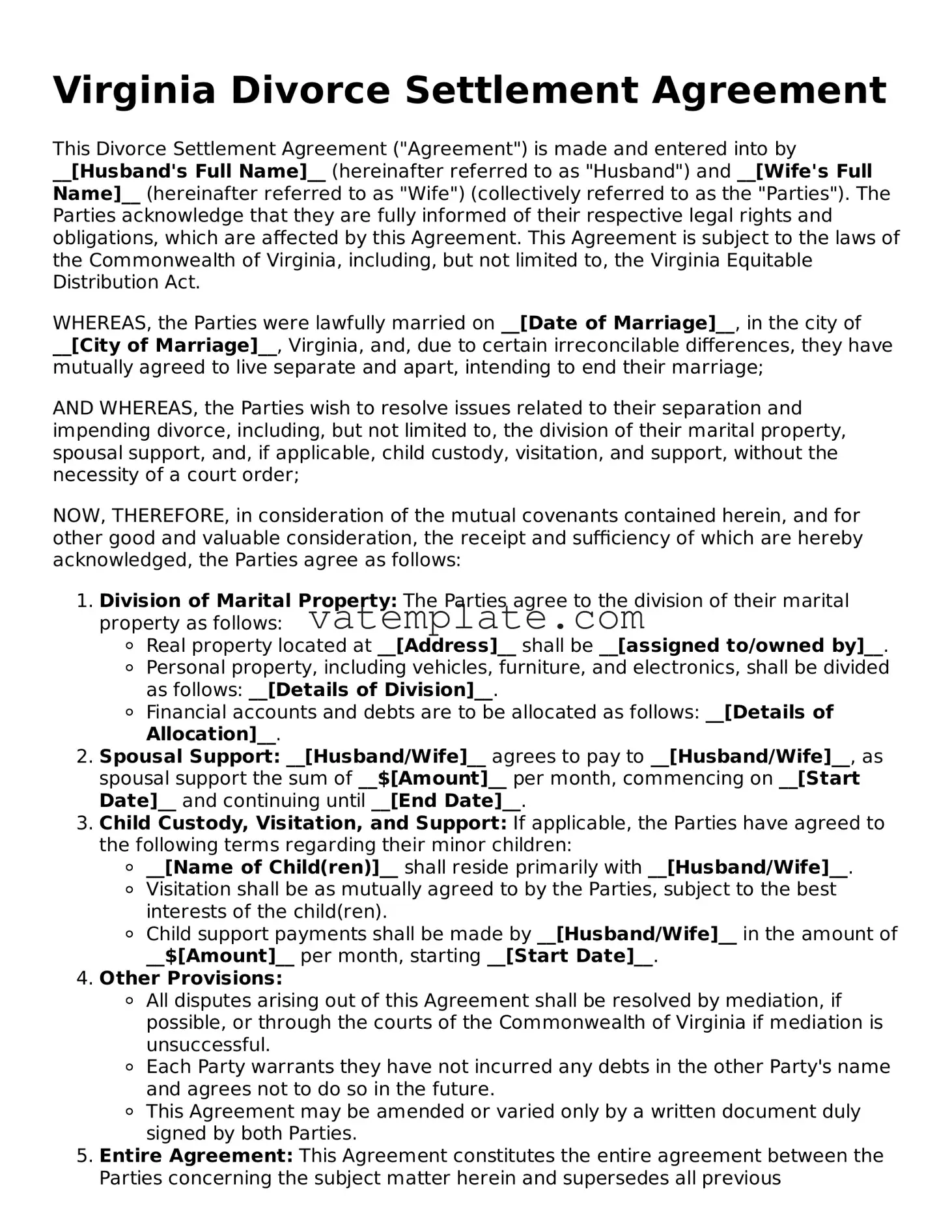Virginia Divorce Settlement Agreement
This Divorce Settlement Agreement ("Agreement") is made and entered into by __[Husband's Full Name]__ (hereinafter referred to as "Husband") and __[Wife's Full Name]__ (hereinafter referred to as "Wife") (collectively referred to as the "Parties"). The Parties acknowledge that they are fully informed of their respective legal rights and obligations, which are affected by this Agreement. This Agreement is subject to the laws of the Commonwealth of Virginia, including, but not limited to, the Virginia Equitable Distribution Act.
WHEREAS, the Parties were lawfully married on __[Date of Marriage]__, in the city of __[City of Marriage]__, Virginia, and, due to certain irreconcilable differences, they have mutually agreed to live separate and apart, intending to end their marriage;
AND WHEREAS, the Parties wish to resolve issues related to their separation and impending divorce, including, but not limited to, the division of their marital property, spousal support, and, if applicable, child custody, visitation, and support, without the necessity of a court order;
NOW, THEREFORE, in consideration of the mutual covenants contained herein, and for other good and valuable consideration, the receipt and sufficiency of which are hereby acknowledged, the Parties agree as follows:
- Division of Marital Property: The Parties agree to the division of their marital property as follows:
- Real property located at __[Address]__ shall be __[assigned to/owned by]__.
- Personal property, including vehicles, furniture, and electronics, shall be divided as follows: __[Details of Division]__.
- Financial accounts and debts are to be allocated as follows: __[Details of Allocation]__.
- Spousal Support: __[Husband/Wife]__ agrees to pay to __[Husband/Wife]__, as spousal support the sum of __$[Amount]__ per month, commencing on __[Start Date]__ and continuing until __[End Date]__.
- Child Custody, Visitation, and Support: If applicable, the Parties have agreed to the following terms regarding their minor children:
- __[Name of Child(ren)]__ shall reside primarily with __[Husband/Wife]__.
- Visitation shall be as mutually agreed to by the Parties, subject to the best interests of the child(ren).
- Child support payments shall be made by __[Husband/Wife]__ in the amount of __$[Amount]__ per month, starting __[Start Date]__.
- Other Provisions:
- All disputes arising out of this Agreement shall be resolved by mediation, if possible, or through the courts of the Commonwealth of Virginia if mediation is unsuccessful.
- Each Party warrants they have not incurred any debts in the other Party's name and agrees not to do so in the future.
- This Agreement may be amended or varied only by a written document duly signed by both Parties.
- Entire Agreement: This Agreement constitutes the entire agreement between the Parties concerning the subject matter herein and supersedes all previous agreements, arrangements, understandings, or proposals, oral or written. This Agreement may be amended only by a written document signed by both Parties.
IN WITNESS WHEREOF, the Parties have executed this Agreement as of the latest date set forth below:
Husband's Signature: ________________________ Date: __[Date]__
Wife's Signature: __________________________ Date: __[Date]__
